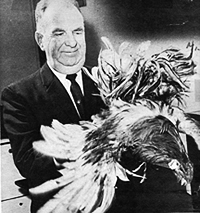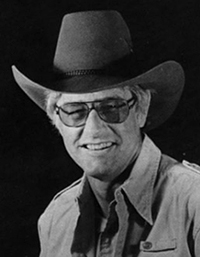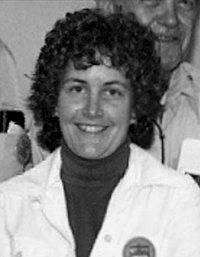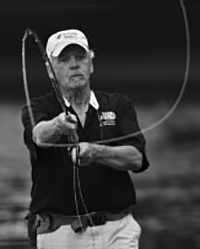The St. Paul Fly Tiers & Fisherman’s Club was established over 60 years ago in order to promote fly tying and fly fishing during a time when there were very few fly fishing or tying resources in the upper Midwest. Today, St. Paul Fly Tiers remains one of the oldest fly tying and fishing clubs in the country.
Where it all Started
In March of 1951, Ben Egger gathered 25 students from adult fly tying classes he taught at Harding High School. They occasionally met at each others homes, and various neighborhood taverns to tie flies and swap stories. In April of 1952 the club was officially formed and incorporated by Egger and seven members of his fly tying group and members of the St. Paul Fly and Baitcasting Club.
By the late 60s and early 70s they had over 100 members. They decided to meet each Thursday at Kuby’s on Rice Street in St. Paul until 1987 when they moved to Tin Cup’s.
The organization was founded prior to the commercial availability of the materials, equipment, and information necessary to fuel tying and fly fishing passions. Originally one of our purposes was to provide a source for furs, feathers and other materials almost impossible to find in the ‘50’s and ‘60’s. As there were no sources of tying materials in the area, the club originally made materials available to its members through various means.
In a March 22, 1976 interview, Egger states, “St. Paul Fly Tiers club was first to blend various kinds of fur in a kitchen blender (which others started again in the 80s with electric coffee grinders-the editors), the discovery was publicized in a fly fishing magazine and as a result, someone invented a miniature blender to do the same.” This trend exploded into commercially available blended dubbing and was the impotence for today’s synthetic blends. Members of the club created many popular fly patterns and fly tying methods, and some of the original members became widely among the nation’s fly tying elite.
Members to Remember – Ben Egger, Harold Arnold, Ray Brundrett, Norm Lucas, Robert Mahler, Jerry Walerius, Tom Walker, Oscar Krevinghous, Mark Tibbets, Bill “Silver Spider” Spies
Did You Know?
- St. Paul Fly Tiers has been around since 1952
- We have over 100 active members
- We tie for and promote all types of fishing
- We support conservation
Notable Members
Andy Miner
Andy was one of our early members. He started the selective breeding of chickens to provide quality dry-fly hackle. Andy, a lawyer from St. Paul, had decided to raise chickens hatched from eggs he got from Harry Darbee. Those eventually became the Hebert Miner necks. Bucky Metz got his eggs from Miner and started Metz Hackle with them. Andy’s experimentation led directly to most of today’s genetic hackles (Whiting, Hoffman, Metz, Keogh etc.). Check out these two articles on Genetic Hackle and the fly fishing industry that credit Andy with his quality process for genetics in “Fly Rod & Reel” magazine and the 1985 issue of “Field and Stream.”

Dave Engerbretson
Dave was an active member while finishing his PhD degree and teaching at Macalester College. He went on to become a professor at Washington State University and the Western field editor for “Fly Fisherman Magazine.”
To most, Engerbretson was best known for his love of fly fishing for more than 35 years. Early on, he conducted his own fly fishing school at the K Bar L ranch in Montana. He was a commercial fly tier for the Orvis Company and a licensed fishing guide on such famous waters as the Henry’s Fork of the Snake River.
In 2002, he was presented with the Charles E. Brooks Memorial Life Award by the Federation of Fly Fishers. In 1986, Engerbretson wrote Tight Lines, Bright Water, an unusual blend of semi-autobiographical treatise and instructional text on all things related to the art and science of fly fishing. The book went on to become a staple of the genre.
Engerbretson was also a prolific magazine writer, lecturer, photographer, tackle designer, and consultant to many fly fishing manufacturers. He served as Western editor for Fly Fisherman magazine for many years.
Until his death in 2003, he was an editor-at-large to the magazine as well as a contributing editor to the Virtual Fly Shop, Cabela’s Guidebooks, and Lefty’s World. He was also the host of the popular PBS television series, Fly-tying; The Angler’s Art, seen nationwide. At the time of his death he was involved in writing a fly fishing textbook and conducting rod handle size research for the Winston Rod Company.

Dorothy (Bergmann) Schramm
Dorothy was secretary of the club before moving to Michigan where she established The Fly Girls of Michigan. A fly fishing club patterned after the St. Paul Fly Tiers.
Dorothy has won numerous awards from the Federation of Fly Fishers, and the Arnold Gingrich Memorial Life Award. In 1998, the IFF presented Schramm with the Woman of the Year Award for her IFFF devotion and participation. The Arnold Gingrich Memorial Life Award is presented to that person of outstanding achievement in any of several areas that are part of, or related to, the sport and science of fly fishing. Those areas include angling writing, original fly fishing theory, conservation and environmental protection, entomology, education in the sport of fly fishing and innovation in fly fishing techniques.
She has worked sports show for Fenwick and Scientific Anglers and has taught in the Sage and Orvis fly fishing schools throughout the Midwest. Schramm is the owner of Rodsmith, a custom rod building and angling-related arts business and is considered to be one of the premier rod builders in the Midwest. In 1996, she founded Flygirls of Michigan, a International Federation of Fly Fisher’s club. The Flygirls was born out of the growing interest in women’s fly fishing.

Bob Nasby
In 2015, Bob was inducted into the Freshwater Fishing Hall of Fame. Fly casting instructor and guide, he is a frequent speaker at sports shows, fishing and conservation clubs as well as a guest on ESPN’s Fly Fish America.
He has also been featured on television and talk radio, plus numerous publications: Outdoor Life, Fly Fishing the North Country, various Boundary Waters publications and many more. He’s pioneered fly fishing on the Great Lakes, guided in the Florida Keys and teaches flycasting (including spey techniques) for all skill levels.
“Nas” is fussy about what rod is in his hand, not about what he is fishing. He has been known to go after tarpon, bonefish, shark, barracuda, steelhead, Great Lakes brown trout, lake trout, Great Lakes carp, smallmouth bass, musky and anything else that will eat a fly.
A fly fishing guide for both fresh and saltwater, his favorite waters are equally varied: Florida Keys, Gulf of Mexico, Great Lakes and their tributaries, boundary waters of Minnesota and the St. Croix River.

